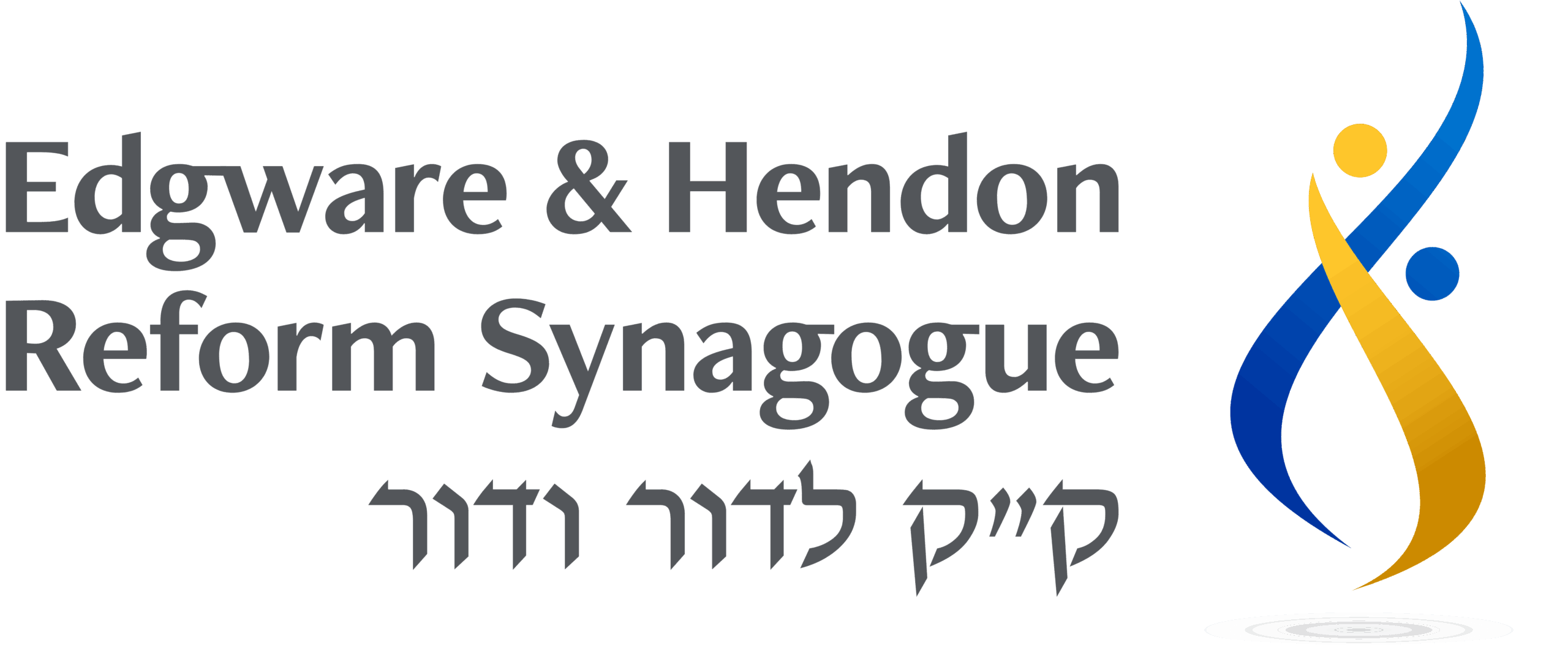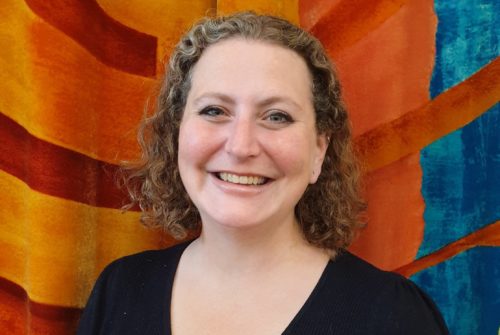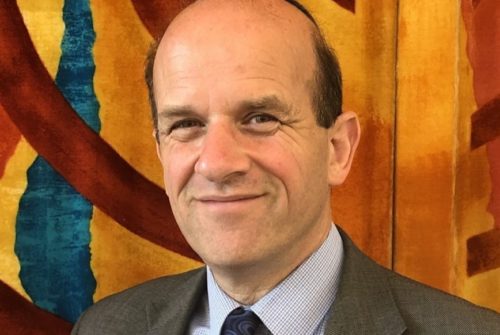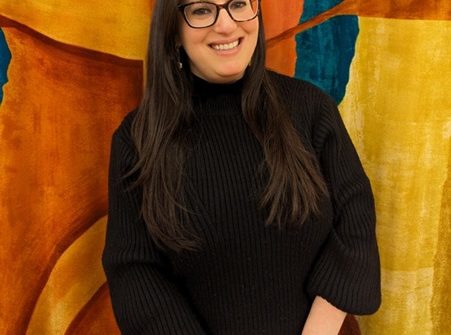Walk into the Tate Britain gallery, forwards through the lobby then turn right into the gallery of British art and sculpture from the 1930’s and 1940’s. You can’t miss it – 2 ½ tons of British alabaster carved with exquisite skill into the point in our Torah portion when Jacob, the man, becomes Israel the people. Sir Jacob Epstein carved his massive and iconic Jacob and the Angel in 1940-1941, just at the point when that people Israel were facing annihilation by the Nazis. It depicts a naked Jacob wresting with an angel – showing the meaning of the word Yisrael – the people who struggle with God. (Genesis 32:29) [ Click here for: Jacob and the Angel, Jacob Epstein, Tate Britain]
The sculpture was so controversial at the time that for many years it was displayed as an adults only attraction at Louis Tussauds Waxworks in Blackpool, near to a real live mermaid (actually a woman with her feet in a painted sack). It was then displayed in a shop in Oxford Street, again adults only. In 1996 it took up its place in the Tate Gallery, seen now as a masterpiece of dramatic sculpture. You don’t have to be an adult to see it today. And indeed this is one of our final Jewish Images of the week of this year’s CRP points season for Jewish day schools before we go back to our old in person system of recording attendance at services.
When Jacob becomes Israel he sets us as a people on the uncertain, sometimes fraught, sometimes glorious journey that brings us to today. Here we are in a Synagogue in London together as Jews whose families have their origins in many different parts of the world, celebrating the Bat Mitzvah of Tammy, expressing our confidence and hope that they will take this people Israel forwards into future generations.
We do so in way that is itself highly symbolic of what it means to be a people Israel. Tammy read a Torah portion today that was also read in every Synagogue of the world. They read this Torah portion known as Vayishlach in Sydney, Australia eleven hours ago, they will read Vayishlach in Boston, USA, in about five hours from now. They are reading Vayishlach in the Synagogues of Israel, Italy and Iceland (there is one shul in Reykjavik, though not another one to go to when you get brouighus!).
Every Shabbat that we hear or study Torah we link ourselves to every Jew around the world. And of course, this Torah portion was read in this week of the Jewish year in every Synagogue for at least 1700 years.
It’s one of the meanings of the Talmudic phrase “Kol yisrael arevim zeh ba zeh” – all of Israel are guarantors for each other. (Shevuot 39a) All Israel learns together and seeks inspiration from the same text together week after week after week into the future.
It means that we support other Jewish communities and help them to thrive, spiritually, intellectually and materially wherever they may be in the world. It was the impulse that led to the foundation of our Movement for Reform Judaism in 1942, as the six Reform communities of the country including ours were dealing with Jewish life in the Second World War, and our duty to make this Movement succeed. It was the impulse behind the foundation of the World Union for Progressive Judaism here in London in 1926, so our Judaism could be accessed world-wide.
There is another critical meaning of believing that “kol yisrael arevim zeh ba zeh” , all Israel, all of the children of Jacob, are guarantors one for the other. It is that we are the guarantors of each other’s memory. We have to be. Judaism and the Jewish people are fueled by memory as much as by our current reality and our future promise.
When you look out of the window of the Leo Baeck College Room of Prayer in the Sternberg Centre, the room where the Rabbis of the future are trained and which serves as the home of our Reform Beit Din where new Jews are accepted into our people, you can see another sculpture as momentous in its way as Epstein’s Jacob and the Angel – Roman Halter’s massive sculpture ZACHOR – just the Hebrew word for remember.
And remember we do. We commemorate the six million killed in the Shoah, the Nazi Holocaust, on Yom Ha Shaoah, Holocaust Remembrance Day. We remember, as today we remember Miriam Adler z’’l, the young woman, killed in the Shoah, for whom Tammy is guardian of her memory.
We remember the devastation that was caused alongside the destruction of the Temples in Jerusalem and the expulsion of Jews from countries in Europe, on Tisha b’Av each year. We remember what Jewish communities successfully built in Europe when we teach about the Golden Age of Spain, the Jewish culture of Germany, of Poland and the Pale Of Settlement in Byelorussia, Ukraine and Russia.
But there is one major strand of Jewish memory which I and others feel has been largely missing in our Synagogue, and actually in most Synagogues of the Ashkenazi world.
This is memory of the enormous loss that took place from the 1940’s onward to the 1980’s of the great Mizrachi, or Eastern Jewish communities. The memory of the Jewish community of Iraq, heirs to Babylonian Judaism, 150,000 in 1948 now perhaps 7 people – that’s right just 7 identified Jews in Iraq today. The Jewish community of Iran – from 65,000 in 1956 and now under 9000. Of Syria, estimated at 30,000 in 1948 and now estimated at 17 individuals, of Tunisia, a good 75,000 in 1948 and now 1500. Egypt, 75,000 Jews in 1948 down to 14, Libya, 38,000 in 1948 now down to zero, Algeria 140,000 and now fewer than 50 Jews. (Source: table from various sources in Wikipedia www.en.wikipedia.org/wiki/Jewish_exodus_from_Arab_and_Muslim_countries)
What happened? Every one of these great Jewish communities has representatives in our EHRS community membership, but we tend to tell only the Ashkenazi story of European Judaism. We know that the Mizrachi majority in Israel now comes mostly from the displacement of Jews from these and other North African and Middle Eastern countries. We know that Israel struggled in their resettlement in the Jewish state but also helped them to get there but do we know why and how it happened, apart from some vague ideas that conditions for Jews in Arab and Muslim countries became difficult or intolerable.
The situation was different in different countries, the Mizrachi Jewish culture lost was varied and rich. Some left amidst violence, some amidst hope for the future. There is a story to be told, and a memory for us to join in guaranteeing.
One way we can do so here at EHRS would be for us to join many Jewish communities around the world every year in commemorating the Farhud, an event in Baghdad, Iraq from June 1st-2nd 1941, which can stand, as the start of Warsaw Ghetto uprising stands for the date of Yom Shoah, as symbol for the huge loss that all Jews should remember. On those two days, Nazi inspired Baghdadi thugs violently attacked the Jewish community and killed at least 180 Jews and destroyed nearly 1000 homes in the Jewish community. The Farhud, which means destruction, stands for the beginning of the devastation of Mizrachi Jewry in its home countries.
We should remember here – for the sake of our members from Iraq, Iran, Libya, Algeria, Yemen and more and for our own sake if we are not from those countries – we should hear the story and we should remember the communities lost. If we remember the Farhud we will hear both about the terror and also about the Baghdadi Muslim families who sheltered Jews. The history is both shameful and praiseworthy. We should remember as a Synagogue community and each of us should ask the people we know what happened to the communities they or their parents grew up in. Zachor – remember. Last year we made a start, with our morning in June at which we learned about the Jewish communities of Baghdad, Safed and the Caribbean, and with our film show on Selichot night, Remember Baghdad with Edwin Shuker. Let these not be a one off.
In the Tenth Century in Italy the Midrash Tanna D’Bei Eliyahu Rabbah was written. In it there is a beautiful illustration of what it means to remember for each other and to celebrate and help each other – even if the Jew who you are remembering has an origin very different from yours. It reads:
“The people of Israel are similar to a ship. If there is a hole in the lower hold, one does not say, ‘Only the lower hold has a hole in it.’ Rather they must immediately recognise that the ship is liable to sink and that they must repair the hole down below.” (Tanna D Bei Eliayahu Rabbah 11)
May EHRS always be among the Synagogue communities that keeps the ship of this people Israel afloat!



